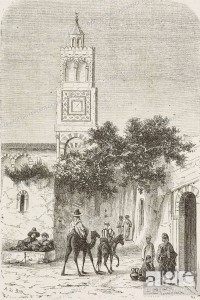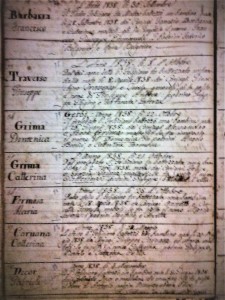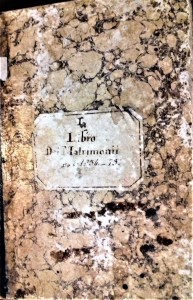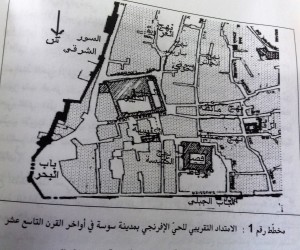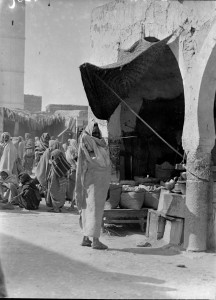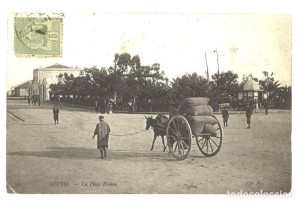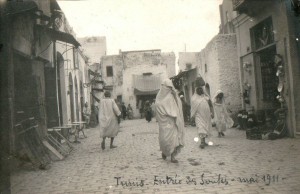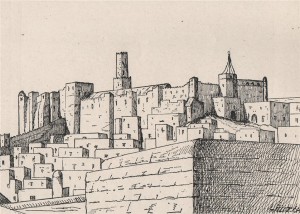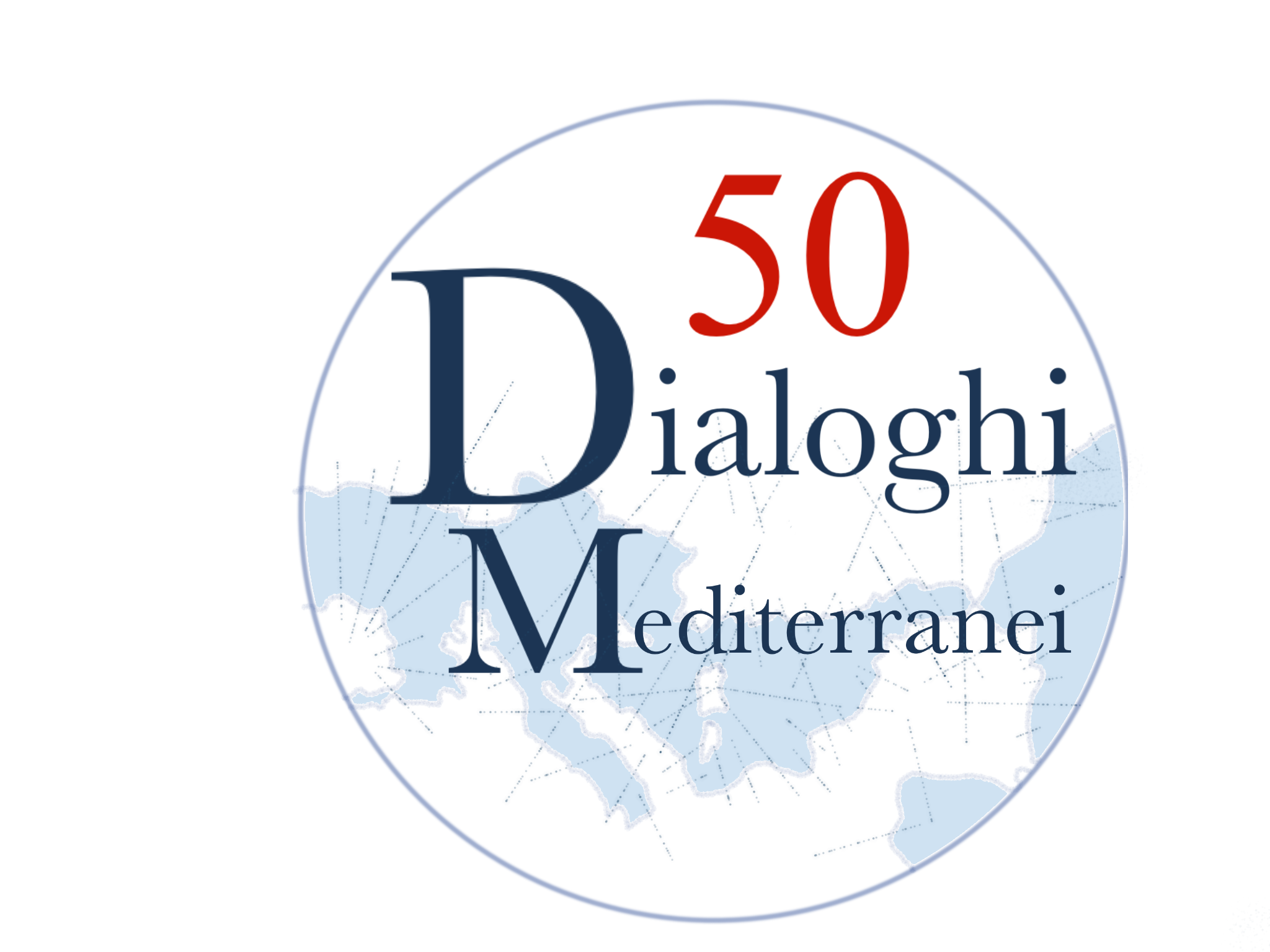di Arnold Cassola [*]
The Libro dei Battezzati in Susa
The Libro dei Battezzati in Susa is marked as Vol. I and runs from “1834 all’anno 1861”. In reality, however, this volume seems to include different smaller registers that were later bound together, the first one running from the period 14th November 1836 till 19th May 1844.
According to Jerfel (2013: 6), the baptismal registers conserved in the Saint-Félix Parish Church show that Maltese births constituted around 75% of all European births in the town during the 1836-1884 period: 80 % of baptised children between 1836 and 1850 and 68 % between 1851 et 1883 were Maltese. The second most represented nationality was that of the “Italians”, who in the 1836-1850 period were made up of seven Sicilian families, five Neapolitan families and two families each from Genova and Sardinia.
Scope of this work is to list the first Maltese in contact with Sicilians and Italians in Sousse and the neighbouring towns in the said period, from 14th November 1836 till 19th May 1844, and to try and establish the social context in which they were living.
The entries in the register are normally in chronological order. However, there are exceptions to the rule where, for example, some Sousse August 1838 baptism entries actually precede a number of July ones.
Identity
A remark on identity: it is evident-from the materials examined in the above mentioned circumstances- that, at least in formal documentation (notarial deeds, parish baptismal or matrimonial deeds) whilst the concept of “Malteseness” is vivo e vegeto, “italianità” is completely missing: persons of Italic descendence are denoted by their regional appellation (siciliano, genovese, napolitano etc.) rather than by their national “italianità”.
Indeed, one can arrive at the conclusion that a substantial number of births registered in the Parish Baptismal registry of Sousse concerned Italians. However, whilst we do have the expressions “siciliani”/“conjugi siciliani” (“Stefano Vairetto siciliano”), “sardi” (“Giovan Battista Rosso e Teresa Sciaccaluga, Conjugi Sardi”), “napolitani” (“Marianatonia Rig napolitana”; “Sig. Pasquale Morelli e Francesca sua moglie Napoletani”), “genovesi” (“Antonio Escano and Maria Sciaccalto, genovesi”), “d’Ischia” (Margherita Monti, d’Ischia”) etc., we never get “italiani” or “conjugi italiani” to denote these people. This is probably a reflection of the fact that politically Italy did not yet exist and that “Italians” identified themselves much more with their actual regional provenance rather than by their “ideal” Italian label.
It is interesting to point out that in the eight year period examined, apart from the Genoese citizens Antonio Escano and Maria Sciaccalto and Teresa, mother of Carolina Fava, the Italian migrants mentioned having a connection with the Maltese were all coming from the impoverished south of Italy, namely the islands of Sardinia, Sicily and Ischia, together with the Naples Campania region, and this coincides perfectly with Ganiage’s Tunis findings, whereby 89.7% of Maltese men married Maltese women, 92.7% of Maltese women married Maltese men, whilst the remaining 8-10% or so, with very few exceptions, were united in marriage to a partner coming from the southern Italian Islands or the Napoli area (Ganiage 1960: 36).
This line of reasoning applied to the classification of Italians did not apply to persons of other nationalities, who are invariably associated with their national context, such as “conjugi Francesi”, “Inglese”, “Spagnuoli”, “Tunisini”, “Svizzero” and, of course, “Maltesi”/ “conjugi Maltesi”.
Maltese mixed marriages
Ganiage (1860: 35-37) has produced clear evidence that in the period 1840-1859 the majority of Maltese men in Tunis married Maltese women. In this nineteen year period, 386 Maltese men were joined in catholic marriage to 386 Maltese women. Ganiage estimates that one out of nine of these couples was given a dispensation to marry because of the consanguinity that existed between the couple.
However, in Tunis, there were also a few mixed marriages. Of these, 20 involved Maltese and Sicilians, 5 Maltese and Sardinians, and 19 Maltese married a partner of other nationalities. Basically, one could conclude that around 10.5% of the marriages celebrated in Tunis in the 1840-1859 period, and involving Maltese people, were actually mixed marriages.
What about the situation in the Sousse parish in the 1836-1844 period, as based on the Sousse marriage register? The following 41 marriages involving Maltese were registered in the 15thNovember 1936 – 24th August 1843 period:
Vento Antonio (???) con Macrino Giuseppa (Maltese)
Borgia Francesco con Vella Marianna (both Maltese) (had children)
Pares Saverio con Strafrac Marianna (both Maltese)
Chicchele Antonio (???) con Sciberras Carmela (Maltese)
Vella Francesco con Gili Maria Concetta (both Maltese)
Fighieri Filippo con Giorgi Teresa (both Maltese)
Fernandes Giovanni (Siciliano) con Farruggia Maria (Maltese) (had children)
Tonna Michele con Vedova del fu Demetrio Melich (both Maltese???)
Fighieri Carmelo con Gilli Anna (both Maltese)
Lepre Giuseppe con Brifa Francesca (both Maltese)
Sofia Giuseppe (Siciliano) con Carmina Zarpa (Maltese)
Farugia Pietro (Maltese) con Morello Nunziata (foreign???)
Attat Giovanni con Pace Maria (both Maltese)
Fighiera Gioachino con Portelli Rosa (both Maltese)
Massa Giovanni Ma. con Tabuni Francesca (both Maltese (with children)
Fighiera Giuseppe con Gilio Teresa (both Maltese)
Attard Giovanni con Maddalena Fsadni (both Maltese with children)
Clarinquet Gioacchino con Cacchia Teresa (both Maltese)
Brista Giuseppe con Migtrud Grazia (both Maltese)
Ellul Antonio con Casar Concetta (both Maltese (with children)
Sait Luigi con Caraona Elisabetta(both Maltese)
Box Lorenzo (Spanish) con Ferrugia Teresa (Maltese)
Rossignaud Giovanni con Farrugia Teresa (both Maltese)
Demelis Salvatore (???) con Debono Rosaria (Maltese)
Merciecca Giuseppe con Grech Saveria (both Maltese (with children) Monastir marriage, child Sousse
Galea Francesco con Debono Maria (both Maltese (with children)
Soffia Alessio con Giorgio Antonia (both Maltese)
Borgia Carmeno con Balzan Eugenia (both Maltese)
Faella Pietro con Borg Antonia (both Maltese (with children)
Agolina Clemente con Balzani Maria (both Maltese (with children)
Bastianini Salvatore (????) con Mical Mariantonia (Maltese)
Spitieri Lorenzo con Dimech Marianna (both Maltese (married in Sousse, with children in Monastir)
Moscati Filippo con Zamit Giuseppina (both Maltese)
Bella Saverio con Menica Ellul (both Maltese) (with children)
Mical Felice (Maltese) con Bonaici Catterina (both Maltese) (with children)
Vella Giuseppe con Condurat Teresa (both Maltese)
Cassar Francesco con Pace Maria (both Maltese)
Mallia Giuseppe con Cammellieri Giovanna (both Maltese) (with children)
Galea Francesco con Felice Maria (both Maltese) (with childrenboth marriage and child in Media)
Ferrugia Luigi con Xiberras Vincenza (both Maltese) (no children, onl godparents)
Failla Vincenzo con Bonel Concetta (both Maltese) (with children)
Azzopardi Felice con Rizzo Giuseppina (both Maltese) (with children)
Muscat Giuseppe con Failla Maria (both Maltese)
Condorat Giovanni con Felice Rosa (both Maltese ???)
Of these 41 marriages, the great majority, thirty three, were contracted between two Maltese nationals. Seven other marriages were contracted between a foreign male and a Maltese woman (Antonio Vento (“Italian”) with the Maltese Giuseppa Macrino; Antonio Chicchele (“Italian”) with Carmela Sciberras; the Sicilian Giovanni Fernandes with Maria Farruggia; the other Sicilian Giuseppe Sofia with Carmina Zarpa; the Spaniard Lorenzo Box with Teresa Ferrugia; Salvatore Demelis (“Italian”) with Rosaria Debono and Salvatore Bastianini (“Italian”) with Mariantonia Mical), whilst only one marriage saw a Maltese man marrying a foreign wife. Such was the case of the Maltese Pietro Farugia who, on 6th October 1837, married the “Italian” Nunziata Morello.
The great majority of these marriages were celebrated in Sousse. However, three marriages were celebrated in Djerba (Luigi Sait with Elisabetta Caraona; Lorenzo Box with Teresa Ferrugia and Giovanni Rossignaud with Teresa Farrugia), two in Monastir (Salvatore Demelis with Rosaria Debono; Giuseppe Merciecca with Saveria Grech), one in Mahdia (Francesco Galea with Maria Felice) and two in Sfax (Giuseppe Brista with Grazia Migtrud; Alessio Soffia with Antonia Giorgio). Francesco Vella and Maria Concetta Gili were married in Sousse, but a note specifies that they were taking up residence in Sfax.
The Sousse baptism register confirms that there are a number of marriages between partners of different provenance as, for example, that between the “Svizzero” Enrico Blagine and the “Genovese” Teresa Croce, who on 26th July 1837 gave birth to a baby daughter, Anna Blagine. She was baptised by Padre Giambattista d’Agnone in Sousse on 18th September 1837.
The baptism register also confirms that there were quite a number of other married Maltese whose marriage has not been recorded in the marriage register. Most probably, these couples had exchanged their vows before marriages actually started being recorded in the Parish registers. Such is the case of what seems to be the first known Maltese man to marry a foreigner in Sousse, Lorenzo Vitale, who had married Margherita Monti, from Ischia, with their daughter Lucia, born on 18th August 1836. The same applies to Marianna Spitieri, who seems to be the first known Maltese woman to marry a foreigner, the Sicilian Angelo Avocato, and who gave birth to a daughter, Emilia, born on 14th June 1837.
Other mixed marriages in Sousse include that between Antonio Miscel, a Frenchman who married a Maltese woman by the name of Carmina (daughter born on 13th November 1837), and that between Paolo Psaila, who was the first Spaniard to enter into a marriage relationship with another Maltese woman, Fortunata Azzopard (first daughter born on 24th December 1837; second daughter birth 24th January 1842).
The other mixed marriages in Sousse consisted in the Sicilian Giuseppe Fernandes marrying the Maltese Maria (first daughter, Giovanna, born on 23rd May 1838) and Gio. Battista Mazza (“Italian”) marrying Francesca Tabuni (first daughter, Carmena, born on 27th May 1837.
In Monastir Giuseppe Marceffa, whose place of birth is unspecified, married Saveria, the daughter of the Maltese Lorenzo Camillari (son born- 10th October 1838, Baptism - 25th April 1839), whilst Menzio [surname unknown], also of unknown origin, married the Maltese Maria Aquilina (son Nicola born - 11th February 1843, Baptism - 6th March 1843). Giuseppe Box, instead, was a Spaniard who married the Maltese Antonia Linguanis. Their two children were Trinitario Box, born on 13th February 1843 and baptised on 6th March 1843 and Pacifico Box, born on 8th March 1844 and baptised on 15th May 1844.
Some uncertainty exists with regards to the exact nationality, Sicilian or Maltese, of Vincenzo Violante and Ignazia Condorato. When they baptised their first daughter, Angiolina, in Sousse in April 1837, they are qualified as “Maltesi”. They must then have moved on to Mahdia, since their two other children were born there. Their daughter Maria was born on 22nd October 1839 and baptised in July 1840. This time, however, the parents are described as “Conjugi Siciliani”. Their third child, Giuseppe, was born and baptised in the month of May 1844. Now, the parents were qualified as “Vincenzo Violante, Siciliano, and Ignazia Condorato, Maltese”. This is possibly the real situation with regards to the nationality of the two.
No precise information is given about the nationality of Pietro Fava, who married the Genoese woman, Teresa, in Sfax.
“Italian” godparents
When it comes to godparents from Italy for Maltese offspring, if one were to exclude the Neapolitan Giuseppe Viestri, the others were all islanders, notably from Sardinia and Sicily. In fact, in Monastir, the Sardinians Giovan Battista Rosso and Teresa Sciacqualuga seem to have been quite active in this function.
Together, they acted as godparents at the baptisms of Teresa Crinquant, (born, 27th April 1839), daughter of “conjugi maltesi” Gioacchino Crinquant and Pasqua Cachia, on 9th March 1840 and Teresa Busuttil (born, 7th May 1844), daughter of “Conjugi Maltesi” Gaetano Busuttil and Anna Cassar, on 13th May 1844.
Rosso then was also godfather to Angelina Spiteri (born, 23rd December 1840), daughter of Lorenzo Spiteri and Marianna, on 11th January 1841, together with a Maltese godmother, Maria Cammelieri. Incidentally, Rosso was accompanied by another Maltese godmother, Grazia Borg, at the baptism of Lucrezia Sciaccaluga (born, 27thFebruary 1843), daughter of the Sardinians Rocco Sciaccaluga and Rosa Paruni on 6th March 1843.
The Sciaccaluga connection with Maltese nationals in Monastir comes up again on 15th May 1844 at the baptism of Pacifico Box (born, 8th March 1844). As already seen, Pacifico was the son of a Spanish father, Giuseppe, and a Maltese mother, Antonia Linguanis. His godparents were the Sardinian Giovan Battista Sciaccaluga and the Maltese Maria Camilleri.
In Sousse there were no Sardinians acting as godparents to Maltese children. In contrast, Sicilians did abound. The Sicilian Don Fortunato Carnazza, together with the Maltese Rosa Cachia, acted as godparent on 12th February 1837 to Maddalena Greco (born, 5th February 1837). Then, the Sicilian couple made up of Angelo Avvocato and Orazia Avocato were the godparents of Carmela Frendo (born, 18th July 1836) on 25th June 1837 while the other Sicilian couple, Gaspare Castro and Elisabetta Passalacqua, were the godparents on 28th July 1838 of Susanna Ferrugia (born, 15th June 1838), daughter of Antonio Ferrugia and Orsola and on 17th November 1839 of Antonino Fernandes (born, 16th November 1839).
Pietro Castro was godfather to three Maltese children. However, while the first baptism, that of Antonina Duaslè (born, 18th December 1839), daughter of “conjugi maltesi” Giovanni Duaslè and Fortunata Pace, was held in Sousse on 28th December 1839, the second and third one actually concerned children born and then baptised in Sfax. The two concerned Sfaxian Maltese were Carolina Borg (born, 7th April 1839), daughter of “Conjugi maltesi” Francesco Borg and Marianna Vella and Carmina Fighera (born 21st July 1839), daughter of Giuseppe Fighera and Maria Teresa. These two baptism ceremonies were held respectively on 14th April 1839 and 22ndSeptember 1839.
The Sicilian Carolina Avocato, together with the Maltese Fedele Borg, was the godparent in Sfax on 23rd September 1839 of Agostino Arnaud (born, 11th June 1839), son of Germano Arnaud and Maria, a Maltese couple. Instead, in Mahdia Giuseppe Castellino and “Lelia di lui moglie” were godparents of the first of the two daughters of the Maltese Vincenzo Zara and Catterina Azzopardi. This baptism was that of Maria Zara (born, 15th February 1838) and was held on 25th February 1838. Two years later, on 5th July 1840, the Sicilian Vincenzo Violante, together with his Maltese wife Ignazia, was the godparent, always in Mahdia, of the second daughter, Carmena Zara (born, 25th March 1840).
Maltese godparents
If a number of Sicilians were godparents to Maltese offspring, this was widely reciprocated by members of the Maltese community, such as Paolo and Vincenza Bonè, who themselves acted as godparents to children of Sicilian parentage. On 17th September 1837 Giuseppe Frento and Barbara Gatt were the Maltese godparents of Emilia Avocato (born, 14th June 1837), daughter of the Sicilian Angelo Avocato and his Maltese wife Marianna Spitieri whilst on 19th February 1839 the Maltese Fortunata Pace was, together with the Sicilian Pietro Castro, godmother of Giacomo Castro (born, 13th February 1839), son of the Sicilian couple made up of Gaspare Castro and Elisabetta Passalacqua.
Pietro Castro partnered the Maltese Maria Mami on 7th March 1841 as godparent of Giuseppe Castro (born, 2nd March 1841), son of the Sicilians Gaspare Castro and Elisabetta Passalaqua, while Maria Basci (born, 2nd January 1842), daughter of Pietro and Rajmonda Basci, had as her godparents on 24th February 1842 Mario Scihar, probably Maltese, and Angiolina Bonardi.
On 16th March 1842, Francesco Failla and Teresa Abela were the two Maltese godparents of Maria Charavalle (born, 1st March 1842), daughter of Giuseppe and Carmela Charavalle, whilst the Maltese Pietro Cassaro was on 12th September 1842, together with the Sicilian Elisabetta Passalacqua, godparent of Salvatore Vairetto (born, 23rdMay 1842), son of the Siculo-Neapolitan couple made up of Stefano Vairetto and Mariantonia Rig.
All the above baptism ceremonies were held in Sousse. Of course, Maltese acted as grandparents to the offspring of Sicilians even in other towns as, for example in Mahdia, where on 5th July 1840 the Maltese Giuseppe Vella and Catterina Zara were grandparents to Maria Violante (born, 22nd October 1839), daughter of the Siculo-Maltese couple made up of Vincenzo Violante and Nazia Condorato, or else in Monastir, where the already mentioned Trinitario Box (born, 13th February 1843), son of a Hispano-Maltese couple, had on 6th March 1843 the Maltese Giuseppe Attard and Grazia Borg as his grandparents.
Of course, there could be other cases of persons of one nationality acting as godparents to the offspring of parents of a different nationality. Such could be the case of Concetta Morello who, together with the Maltese Giuseppe Ellur, was on 8th August 1838 godmother of Carmela Fighiera (born 23rd July 1838), daughter of Nunziato and Regina Fighiera, or else of Giammaria and Giovanna Massa, godparents on 26th May 1840 of Carmena Mifsud (no birth date), daughter of the Maltese Salvatore Mifsud and Maria Patignotta. Unfortunately, however, one cannot pinpoint the exact nationality unless this is expressly mentioned, since a name like Concetta or a surname like Massa are common to both Maltese and Sicilian onomastics.
The officiating celebrants
During this eight year period there were seven officiating Capuchin friars based in Sousse who baptised the offspring of Maltese immigrants to the coastal parts of Tunisia. Five were Italian and two of these were actually Maltese. Interestingly, none of them was Sicilian, though the majority of “Italian” migrants in Sousse were Southern Italians and, in particular, Sicilians.
The first monk was Padre Giambattista D’Agnone, Cappuccino Missionario Apostolico, who officiated baptisms between 14th November 1836 and 19th November 1837. He was followed by the first known Maltese priest in Sousse, Padre Feliciano, Cappuccino da Malta, for the period that went from 24th December 1837 till 18th November 1838.
Padre Luigi da Civitanova, Missionario Apostolico Cappuccino, served for two periods in the Parish of Sousse, the first one going from 19th February 1839 till 28th April 1839 and the second one from 10th November 1839 till 14th September 1840. In between these two terms, it was the turn of the Apostolic pro-Vicar Padre Luigi da Taggia, who took over for the period that went from 12th June 1839 till 2nd October 1839.
Another person who served for two terms in the Sousse parish was Padre Raffaele da Malta, Cappuccino Missionario Apostolico. His first term of baptisms ran from 22nd November 1840 till 18th January 1844. In reality, his second term consisted in only one “Maltese” baptism, that of Giovanni Cristina, son of the Maltese couple, Gabriele and Maria Cristina, which was celebrated on 26th April 1844.
Giuseppe Maria da Lugnano, Missionario Apostolico Cappuccino, oversaw only three baptisms in the short space of 7 days, going from 28th February 1844 till 6th March 1844, until the Rev.mo (??) Padre Vicario Apostolico, Fedele da Ferrara, took over, as from 13th May 1844.
Concluding Remarks
It seems quite evident that during the first years of recorded migration of the Maltese to the coastal towns of Tunisia, they did tend to marry amongst themselves, as was the trend in the capital, Tunis. In the same way, in the beginning “Italians” also tended to marry their own compatriots. The dictum “mogli e buoi dai paesi tuoi” was very often strictly adhered to.
However, as time went by, the intermarrying between different nationalities became more akin to the norm. As years passed by and generations gave way to other ones, the common sense of belonging to a “Tunisian” identity took over from the original nationalistic sentiment that had been the hallmark of parents or grandparents.
The transformation of one’s identity from Maltese/”Italian” ˃ Tunisian ˃ French ˃ “pieds noirs” could well have been the parcours of hundreds, if not thousands, of migrants in Tunisia, on the model of the well-known case of Edwige Fenech, born of a Maltese father and an “Italian” mother in Bône (now Annaba), Algeria.
Ultimately, the history of Maltese/“Italian” migration to Tunisia in the 19th century simply reflects the flows and patterns of migration anywhere and anytime in history.
Dialoghi Mediterranei, n. 43, maggio 2020
[*] Abstract
Questo articolo è frutto della ricerca nell’archivio parrocchiale di Sousse e costituisce una piccola parte del mio lavoro in corso. Passa in rassegna le relazioni tra maltesi e italiani nelle città costiere della Tunisia nel periodo 1836-1844, vale a dire otto anni dopo che il Bey di Tunisi aveva concesso ai cristiani il permesso di fondare parrocchie cattoliche in Tunisia. A Sousse, maltesi e siciliani, tutti caratterizzati da un comune background agricolo e condizioni economiche precarie, hanno iniziato a condividere la vita quotidiana e gli interessi collettivi nel nuovo contesto maghrebino. Siciliani e Maltesi sono diventati in pochi anni protagonisti delle attività commerciali in città. L’archivio parrocchiale di Sousse registra matrimoni misti a Sousse e a Mahdia tra il 1836 e il 1844. Inoltre, è documentato che molti Siciliani assunsero la funzione di padrini dei figli delle famiglie maltesi a Sousse così come i Maltesi furono padrini dei bambini siciliani a Mahdia nello stesso periodo. Sembra, tuttavia, che i Siciliani non abbiano avuto alcun riconoscimento come rappresentanti di comunità religiose a Sousse. Infatti, dei sette frati cappuccini incaricati della parrocchia di Sousse nel periodo 1836-1844, cinque erano italiani, provenienti da diverse regioni ma non dalla Sicilia, mentre due erano maltesi. Questi numeri riflettono una rappresentanza proporzionale nei confronti dei maltesi, ma non rendono giustizia ai migranti siciliani che costituivano una larga maggioranza rispetto agli italiani insediati nella zona in quel momento.
______________________________________________________________
Arnold Cassola, accademico e politico, ha insegnato nelle Università di Catania (1981-83) e Roma La Sapienza (1983-88). Dal 1988 insegna Letteratura Maltese comparata presso l’Università di Malta, dove ricopre il ruolo di Professore Ordinario. Si interessa di migrazione maltese in Sicilia e in Tunisia, Relazioni culturali italo-maltesi, Storia della Lingua Maltese, Letteratura maltese comparata, e Studi Maltesi in generale. È autore di numerose pubblicazioni. Come politico, Cassola, che ha la doppia cittadinanza malto-italiana, è stato eletto due volte Segretario Generale a Bruxelles del Partito Verde Europeo (1999-2006), e parlamentare alla Camera dei Deputati di Montecitorio (2006-2008), come Italiano all’Estero.
_______________________________________________________________



